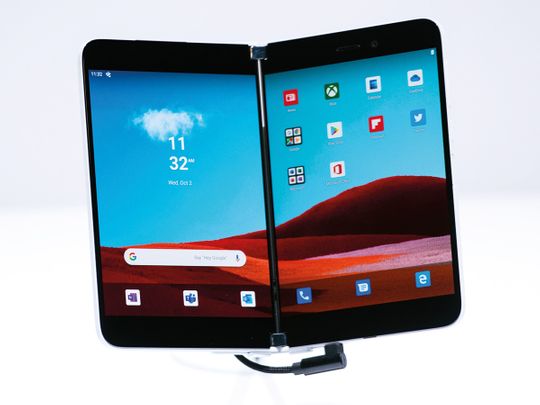
Seattle: Microsoft Corp unveiled a dual-screen, foldable phone that will run on Google’s Android operating system, jumping back into the handset market after product failures and costly write downs pushed it out three years ago.
The phone, called the Surface Duo, has two 5.6-inch screens and will ship in time for the 2020 holiday season, Microsoft Chief Product Officer Panos Panay said at an event in New York Wednesday. With the Duo, Microsoft will seek to seize a share of a massive global market for mobile phones that’s on the cusp of transitioning to new technology with the arrival of 5G networks.
Chief Executive Officer Satya Nadella took Microsoft out of the phone business in 2016, three years after the purchase of Nokia Oyj’s handset unit for more than $7 billion failed to arrest Windows’ sliding share in the smartphone market.
Since then, company executives have repeatedly said Microsoft wouldn’t re-enter that market unless it had something different to offer. A return to phones this time has Microsoft relying on software rival Google’s Android for the operating system. Android powers the large majority of smartphones around the world. “This is an aggressive move that was not expected by the Street,” said Wedbush Securities analyst Daniel Ives. “We view it as a smart strategic gamble by Nadella to jump back into the deep end of the pool on the smartphone front.’’
The new phone makes sense for Microsoft because any company that’s serious about hardware needs to have a mobile play, said Ryan Reith, an analyst at research firm IDC. The most interesting thing about the announcement is the dual-screen form, Reith said. It’s likely Microsoft made that choice because a regular phone wouldn’t have stood out as much among the dozens of alternatives already out there, he said.
The move also draws Microsoft further into a hardware business some investors still haven’t warmed to. Microsoft shares were down 2.2 per cent to $134.01 at 12:31pm in New York.
Nadella has been quick to embrace rival products where it advances Microsoft’s goals, such as apps for Android and Apple Inc’s iOS, and using the Linux operating system within Windows and Azure cloud products.
The European Union’s antitrust ruling against Google last year over the way it puts search and web-browser apps onto Android devices also means Microsoft would be freer to merge its own apps with Android. Since the EU’s case, it’s now possible for a phone maker to use Android and the Play App Store and still preinstall all of its own services on the homescreen.
Microsoft and Google make competing sets of productivity software, and it remains to be seen which company’s apps will be preloaded on the phone. Still, it’s unlikely the handset will become a major battleground for the two, Reith said.
“Both risk their productivity suites competing with each other but there’s more short-term opportunity for them collaborating,’” he said.
Other announcements made at Microsoft’s annual hardware event include a new Surface Neo laptop with a 360-degree hinge and two 9-inch screens so it can open like a book or like a laptop. The device has a removable, flipable keyboard, which magnetically seals to the back of the device, along with a pen. It will run a new version of Windows 10 designed for dual screens called Windows 10X.
The new foldable Surface products come as companies like Samsung Electronics Co. and Huawei Technologies Co. have also rolled out phones with similar features, albeit after some initial design difficulties, and PC makers like Lenovo Group Ltd. have shown computer prototypes with folding screens.
Microsoft also introduced a completely redesigned version of its Surface Pro hybrid tablet-laptop that’s thinner, lighter and faster than previous models and runs on a customised processor with Microsoft and Qualcomm Inc technology. Called the Pro X, the device also has a custom artificial intelligence processor and better battery life. The device’s pen gets stowed in the tablet’s cover where it wirelessly charges. Microsoft also showed off white, circular Surface earbuds that have touch controls to enable the user to take calls and switch music. They will be available later this year starting at $249.
Redmond, Washington-based Microsoft relies on its Surface devices to boost sales as well as show off its software and attract customers to its family of products. Many of the products have been well reviewed, though Microsoft lags behind Apple and other hardware vendors in popularity. Microsoft held a 3.6 per cent share of the worldwide tablet market in the second quarter of this year, making it the No. 6 vendor with shipments of nearly 1.2 million units, according to IDC. That represents growth of 48 per cent compared with a year earlier. Apple by comparison was No. 1 in with a 38 per cent share.
Microsoft also presented a new laptop and an update to the existing Surface Pro device.
The new Surface Laptop 3 will have an aluminium exterior finish, “instant on” and a bigger trackpad. The device will be available with a 15-inch screen and fast charging. Panay said the product is three times more powerful than Apple’s MacBook Air. The devices can be pre-ordered starting Wednesday and will be available Oct. 22 at $999 for the 13-inch and $1,199 for the 15-inch.
The Surface Pro 7 comes out the same day and starts at $749.
Microsoft’s device revenue topped $6 billion in the year that ended June 30, including Surface units and PC accessories, according to its annual filing. The company uses the devices to attract corporate users to its hardware and programs, while Apple dominates the consumer part of the market, according to Wedbush’s Ives.
“Surface represents the tip of the spear of the broader Microsoft ecosystem as Microsoft still needs a horse in the race on next generation consumer hardware and devices,” Ives said. “While some investors continue to question this investment as good money going after bad endeavours on Surface, we strongly disagree as this remains a mind and market share strategic gamble.”











